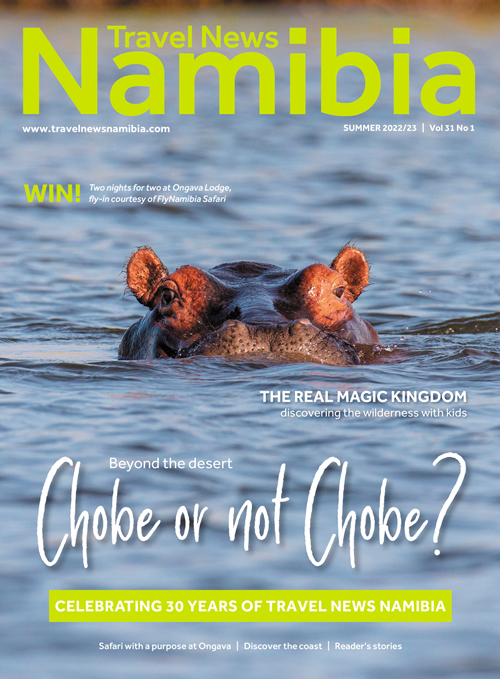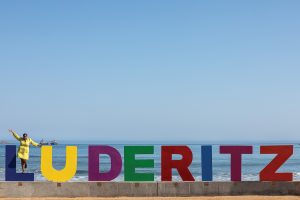
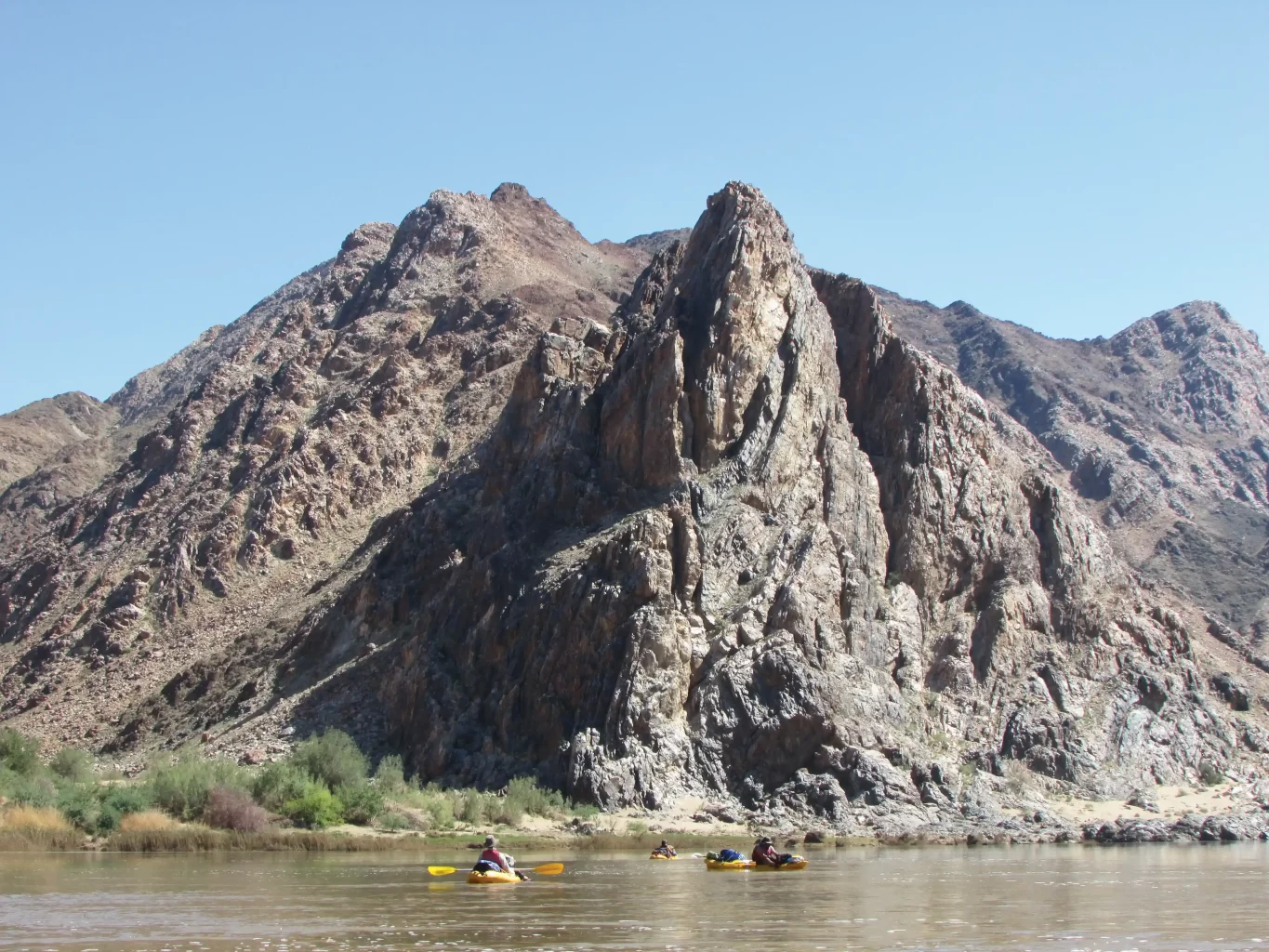
ORANGE RIVER ADVENTURE – Down the river from drift to drift
Text & Photographs – Piet van Rooyen
the Summer 2022/23 issue
“This one is too big for any of us. We will have to do a portage.” We all agree. We have been coming fine all along the Orange River over the last five days, no use messing up so near the finish line.
The previous five days were a magnificent experience. It is mid-April. We are doing a canoe trip down the Orange River from Vioolsdrift to Sendelingsdrift by courtesy of Umkulu Safaris, based at The Growcery (spelling correct) on the southern bank of the river. Our guide is Josias Servaas Fick (Sas for short), accompanied by his Australian blue heeler cattle dog bitch (Kyla for short). The river was at dangerously high levels just the previous week, but was quite manageable by now. We are a group of six canoeists, doing the new experimental run down-river on six brand new sit-on-top plastic kayaks. The boats have been performing exquisitely well from the start and took most rapids with elegance and speed. The few times we got spilled, it was the quick reaction of Sas that saved the day, and the paddler.
We were one each per kayak and carried two dry bags with our food and sleeping gear – one secured at the stern of the kayak, another one in the bow. We managed to paddle about 40 kilometres each day, greatly assisted by the strong current carrying us downstream.
Umkulu Safaris is a Namibian-owned company operating not only kayak trips down the Orange river but also photographic safaris into Namibia and Botswana. They provide all meals on the river, although the paddlers have to help with the transport of foodstuffs and cooking gear. Each paddler also has to transport their own sleeping bag, inflatable mattress and pillow. The kayaks are sturdy and stable enough to allow quite a few extra kilograms of personal luxuries. For our cameras we had double zip-lock bags to keep them dry.
At night we camped on a sandbank, hoping to be far enough from the big-tailed scorpions that are so abundant in these areas in summertime. Kyla, the cattle dog, made sure that we socially integrated as a group. Before the first day was over all of us were good friends. That shows you what a shared experience of nature can do. Kyla accepted each of us as part of her pack. Every morning she came to wake us one by one by pressing her wet nose against our foreheads, where we lay in our sleeping bags. This waking-up ritual preceded the slow dawn. We got up to help Sas prepare the food. We got our tummies filled. Soon afterwards the next stretch of paddling started. Hour after hour the river scenery rolls by. Water monitors in the reeds, vervet monkeys in the wait-a-bit trees lining the banks, fish eagles calling from the high branches.
Here, the Orange runs through one of the driest regions in the whole of southern Africa. It is strange to realise that this river drains masses of water from the Free State and Gauteng provinces in South Africa on its way to the Atlantic Ocean. The origin of all the water is the Indian Ocean, from where it rose to form rain clouds. The banks are lined with tamarisks, karee, sweet-thorn and wait-a-bit thorn trees, all getting their water directly from the river, and not from rain, because there is none of that luxury down here. This is the Richtersveld, a true desert in all respects.
In spite of the arid surroundings, the birdlife along the river is abundant, with plenty of geese, ducks, spoonbills, cormorants, buzzards, hawks and eagles. They did not see us as intruders but kept calmly glancing at the kayaks as we drifted past. There were many opportunities for taking good photographs.
Towards the end of our trip we found several abandoned diamond mines along the river. Dilapidated and rusting machinery was evidence of failure and loss of fortunes. Sas told us stories of some fortune-seekers losing their lives trying to cross the river with a pocket full of diamonds illegally taken from the gravel heaps of these abandoned mines. We were careful not to drown in the rapids ourselves.
The rapids needed a specific approach. We were fortunate to progress step by step as the difficulty grading steadily increased the further we went. The first rapids were only a slight acceleration in the speed of the water with a ripple on the surface. The next ones and the ones thereafter became progressively more challenging. The ideal was to get through them without getting spilled. But even when spilled, all was not lost. A quick flip could turn the kayak back up the right way, with the dry bags protecting our gear and groceries. We steadily gained confidence in ourselves and our guide. With daytime temperatures approaching 40 degrees Celsius, and a full moon up, we even started paddling at night, the river a broad and pale presence around us and into the unknown in front of us.
The rapid just before Sendelingsdrift is man-made, and therefore more dangerous than the natural ones. Here, a weir dams up the water in a wide reservoir, for extraction by the nearby mines and settlements. We carried the kayaks over the sharp stones. We never realised our boats were so heavy until we had to lift them from the water!
The final stretch was flat and slow. We reached the punt at Sendelingsdrift just before lunch. This was an experience not to be forgotten soon. The next one could take us even further, right down to the ocean this time. It is only two days more, in any case.
More to explore

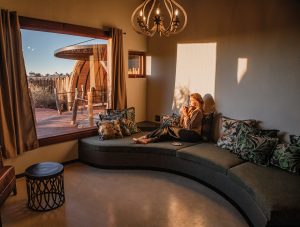
Kalahari Red Dunes Lodge: Setting the tone with Toto’s “Africa”
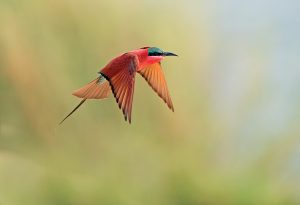
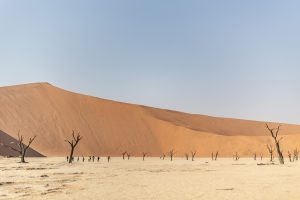
Stitching together the tapestry of memory: A family trip to Sossusvlei
Read full issue online
Lorem ipsum dolor sit amet, consectetur adipiscing elit. Ut elit tellus, luctus nec ullamcorper mattis, pulvinar dapibus leo.


